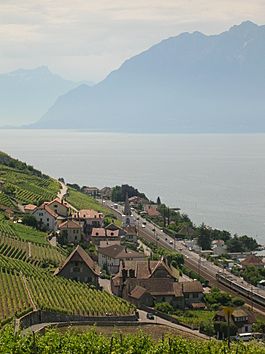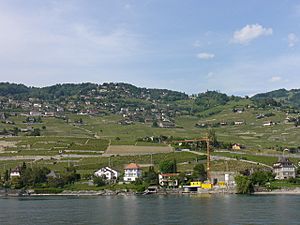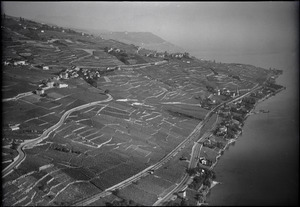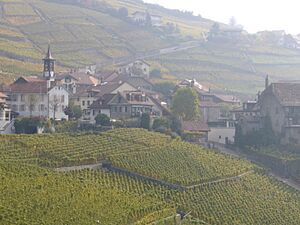Villette, Vaud facts for kids
Quick facts for kids
Villette
|
||
|---|---|---|

Villette village
|
||
|
||
| Country | Switzerland | |
| Canton | Vaud | |
| District | Lavaux-Oron | |
| Area | ||
| • Total | 1.37 km2 (0.53 sq mi) | |
| Elevation | 467 m (1,532 ft) | |
| Population | ||
| • Total | 593 | |
| • Density | 432.8/km2 (1,121/sq mi) | |
| Demonym(s) | Lè z'Aragne | |
| Postal code |
1091
|
|
| Surrounded by | Forel (Lavaux), Grandvaux, Lugrin (FR-74), Lutry, Meillerie (FR-74), Savigny | |
Villette used to be a town (called a 'municipality') in Switzerland. It was located in the Vaud region, specifically in the Lavaux-Oron District.
On July 1, 2011, Villette joined with other towns like Cully, Epesses, Grandvaux, and Riex. They all became part of a new, bigger town called Bourg-en-Lavaux.
Contents
Villette's Location and Land Use
In 2009, Villette covered an area of about 1.37 square kilometers (0.53 square miles). A large part of this land, about 69.3%, was used for farming. This included growing crops, pastures for animals, and vineyards.
Only a small part, about 1.5%, was covered by forests. The rest of the land, about 28.5%, was built up with buildings and roads. A tiny bit, 2.2%, was covered by lakes.
Villette was once part of the Lavaux District. But on August 31, 2006, it became part of the new Lavaux-Oron district.
Villette's Coat of Arms
The official symbol of Villette, its coat of arms, has a special design. It is split into two halves: one silver and one red. On this shield, there is a grapevine with green leaves. The colors of the vine switch depending on the background color behind it.
People Living in Villette
In 2009, Villette had a population of 593 people. About 18% of these people were foreign nationals. Over ten years, from 1999 to 2009, the population grew by 5%. This growth was partly due to people moving in and partly from births.
Most people in Villette (about 88.5%) spoke French in 2000. The next most common language was German (4.6%), followed by English (2.0%).
In 2000, about 23.8% of the people living in Villette were born there. Another 38.1% were born in the same region (canton). About 20% of the people were born outside of Switzerland.
In 2008, there were 5 babies born and 4 deaths in Villette. The number of Swiss citizens stayed about the same, while the number of foreign residents increased slightly.
Age Groups in Villette
In 2000, children and teenagers (ages 0-19) made up about 24.8% of the population. Adults (ages 20-64) were the largest group, at 61.2%. Seniors (over 64 years old) made up 14% of the population.
Homes and Households
In 2000, there were 217 private homes in Villette. On average, each home had 2.6 people living in it. About 21.7% of homes had only one person. There were also homes with married couples, with or without children, and single parents.
More than half of the homes (52.4%) were owned by the people living in them. In 2000, there were 170 inhabited buildings in Villette. Most of these (55.9%) were single-family homes. There were also multi-family buildings and buildings used for both homes and businesses.
The chart below shows how Villette's population has changed over time:

Important Heritage Sites
Villette is home to a special place that is recognized by UNESCO. It's part of the Lavaux, Vineyard Terraces, which is a World Heritage Site. This means it's a very important cultural and natural place for everyone to protect. The entire village of Aran, which is near Villette, is also considered an important Swiss heritage site.
Villette's Economy
In 2010, Villette had a very low unemployment rate of 1%. This means almost everyone who wanted a job had one.
In 2008, many people worked in farming (the primary sector). There were 16 businesses related to farming. A smaller number of people worked in manufacturing and construction (the secondary sector).
The largest number of jobs were in the tertiary sector, which includes services. This sector had 14 businesses and 85 employees. Many of these jobs were in hotels or restaurants.
Most people who lived in Villette traveled outside the town for work. About 63.5% of workers used a private car to get to their jobs.
Religion in Villette
According to the 2000 census, about 27% of the people in Villette were Roman Catholic. A larger group, about 48.2%, belonged to the Swiss Reformed Church. There were also smaller numbers of people who belonged to other Christian churches.
About 17.55% of the population did not belong to any church.
Education in Villette
Many adults in Villette have a good education. In 2000, about 30.5% of the population had finished high school. Even more, about 27.8%, had gone on to higher education, like a university or a specialized college.
In 2000, 23 students came to Villette to attend school. However, 100 students who lived in Villette went to schools outside the town.
Images for kids
See also
 In Spanish: Villette (Lavaux) para niños
In Spanish: Villette (Lavaux) para niños









